Reiss Grey Flower (2013): The Cultivated Scent of Excess {Perfume Review & Musings}

Grey Flower by Reiss is one of the two debut perfumes by the fashion label, which are pretending only in appearance to abide by the conventional rules of launching a her-and-him duo. I am going slowly through new perfumes and so I will leave aside for now the masculine counterpart Black Oudh in light of smelling Grey Flower, which is a full experience in and ot itself.
The inspiration for the name comes from the very delicate nuances of dusty grey you find in hydrangeas, in the centers and edges of their petals - a refined, subtle color and sensation resembling the color of dove necks, but also, to my mind, of mortuary flowers...
Yet, Grey Flower is only partly subtle. It also employs shock-and-awe-tactics. It is first of all extraordinarily intense - and on the surface, grey, yes, convincingly so, as if the mists of Avalon had descended upon it recreating the sensation of a grey chiffon shawl. This is a veil of misty shrouds over a body of strong dark, boozy liqueur smelling of black amber- "black jasmine" actually, and this comes through a moment later as the animalic accents intensify. It is also a saturated fragrance and teases you with the idea of putridity.
Apologies in advance to Reiss who might not like the association, but I say this in a good way, and without adhering to necrophilia aesthetics, the fragrance composition could be the one worn by The Corpse Bride on her wedding day, you know the living-dead animated character in the Tim Burton movie. Emotional perfume wearers are going to love this. This perfume is not about appropriatness. It is about pushing sensory boundaries and flirting with disaster. Grey Flower is most of the time on the verge of smelling like a tombstone flower fattened by the flesh of the dead, even more so than Serge Lutens De Profundis. It is going to be too much for some and interestingly Gothic-and-Romantic-feeling for others, although it is not a sad, downcast fragrance. It is more, objectively speaking, akin to the atmosphere of a vault as if it were natual to live in one. If you compare it with Messe de Minuit by Etro, it is less evocative of mummia though, the ingredient once kept in jars by pharmacists as medicine and harvested from Egyptian mummies. It is less sepulchral.
When the scent starts mellowing down it smells of a complex incense blend, a recipe that no doubt was brought back from the deserts of Arabia. While the opening is shocking, forceful, the drying-down is still not easy but more about that sensation of smelling clothes fumigated with incense. The swirls of smoke were caught in the folds of a drapey, heavy garment. The oud-y-incensey sensation after a while reminds you most closely of the one featured in Elle d'Elissa, the signature perfume of Lebanese singer Elissa.
The structure of the fragrance is textbook niche as it plays upon a fairly linear structure with a forceful case of overdose. The effect is also the one sought out by this school of perfumes: to smell distinctive in a manner that sets you apart from the crowd, which is ironic when you think that grey is usually the color associated with self-effacement in sartorial codes. But in perfumery, the codes are reversed. If you think of Iris Gris by Fath and Grey Flannel by Geoffrey Beene, you know grey is used to make a statement about being out of the ordinary.
There is a liquorishy quality to Grey Flower which makes you think of Chinese snake liqueur, only dustier, but still medicinal. The fragrance retains a spicy-medicinal character.
The development once it gets into its groove is very unilinear. This is not a symphonic perfume in its built. Rather, some unexpected nuances, like citrusy ones, emerge to reveal a hidden, natural complexity. The perfume feels unisex although it is tagged as a feminine, even though there is a masculine counterpart, Black Oudh.
The longer drydown is not what you might expect but it makes sense on three different levels at least: 1) it allows you to "cleanse your palate" after the overload of stongmen notes 2) it plays upon a recent, hip trope of niche perfumery which was developed by Serge Lutens with L'Eau who accorded creative niche status to soap - according to that code, you can smell both of clean, minimalist soap and incense; 3) It brings "simplicity relief" effect tying into a very modern current of sensitivity to soapy smells and white musks, ending smelling like Ivory soap as on a basic level it is undeniably popular. There is room for thinking this is reverse snobbery in this context - but it still affirms the popularity of the smell.
The designers including artistic director Azzi Glasser wanted to create a "shocking" fragrance - in perfumery, there is the antecedant of Shocking by Schiaparelli for the concept. They absolutely succeed on that front as - and this is almost a spoiler alert - the opening shocks your senses to the point of disgust as when you reach a point of oversaturation, even of good things. The composition plays with those thresholds of psychological tolerance. If we are perhaps more aware that beauty can hurt and be a cause of suffering thanks to Kant, beauty can also makes you occasionally want to throw up when it's too much and the stimuli come rushing in overloading your senses. This is what Grey Flower does to you, calling your attention to how borderline disgusting plentiful good things can be.
Fragrance notes: artemisia, pimento berry, sequoia wood, jasmine noir accord, cocoa leaf, skin musks, olibanum, amber crystals, patchouli and baies.
You can read more information about the fragrance here.










